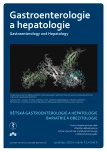Surgical treatment of obesity and metabolic disorders – new challenges for different specializations
Authors:
Fried M.
Authors‘ workplace:
OB klinika a. s., Centrum pro léčbu obezity a metabolických onemocnění, Praha
Published in:
Gastroent Hepatol 2019; 73(6): 468-471
Category:
doi:
https://doi.org/10.14735/amgh2019468
Overview
Methods of bariatric and metabolic surgery have experienced major changes over the past 7 decades. One of the most important changes was the introduction of laparoscopic/minimally invasive approaches in the early 1990s, resulting in the more widespread performance of bariatric surgery worldwide. The shift from bariatric surgery to metabolic surgery is regarded as another substantial change in treatment, as the most important measure of success in metabolic surgery is the improvement or remission of metabolic parameters, such as type 2 diabetes mellitus and hypertension, rather than weight loss on its own. Despite increasing numbers of bariatric and metabolic procedures, only a small proportion of potentially eligible patients undergo these treatments. Reasons for refusal include concerns of both patients and referring physicians of the risks and excessive invasiveness of these procedures, their irreversible anatomical changes, and distrust in treatment results. New technical developments and treatment algorithms target these concerns, with the goal being to use less invasive surgical methods, and to directly involve different medical specialties and treatments. Examples include gastroenterologists performing endoscopic gastric plication or partial jejunal bypass, as well embolization of the left gastric artery. Patients generally prefer less invasive treatments, although it may result in moderate effectiveness, rather than highly infective, but highly invasive, riskier treatment.
Submitted: 3. 10. 2019
Accepted: 9. 10. 2019
Conflict of Interest: The author declares that the article/ manuscript complies with ethical standards, patient anonymity has been respected, and he states that he has no financial, advisory or other commercial interests in relation to the subject matter.
Publication Ethics: This article/ manuscript has not been published or is currently being submitted for another review. The author agrees to publish his name and e-mail in the published article/ manuscript.
Dedication: The article/ manuscript is not supported by a grant nor has it been created with the support of any company.
The Editorial Board declares that the manuscript met the ICMJE „uniform requirements“ for bio medical papers.
Keywords:
bariatric and metabolic surgery – type 2 diabetes – new therapeutical approaches
Sources
1. Fried M, Peskova M, Kasalicky M. The role of laparoscopy in the treatment of morbid obesity. Obes Surg 1998; 8 (5): 520–523. doi: 10.1381/096089298765554089.
2. Fried M, Peskova M. Gastric banding in the treatment of morbid obesity. Hepatogastroenterology 1997; 44 (14): 582–587.
3. Buchwald H, Varco RL (eds). Metabolic Surgery. New York: Grune and Stratton 1978.
4. Sjöström L, Narbro K, Sjöström CD et al. Effects of bariatric surgery on mortality in Swedish obese subjects. N Engl J Med 2007; 357 (8): 741–752. doi: 10.1056/NEJMoa066254.
5. Christou NV, Sampalis JS, Liberman M et al. Surgery decreases long-term mortality, morbidity, and health care use in morbidly obese patients. Ann Surg 2004; 240 (3): 416–423; 423–424. doi: 10.1097/01.sla.0000137343.633 76.19.
6. Angrisani L, Santonicola A, Iovino P et al. Bariatric surgery and endoluminal procedures: IFSO worldwide survey. Obes Surg 2017; 27 (9): 2279–2289. doi: 10.1007/s11695-017-26 66-x.
7. Zacharoulis D, Bakalis V, Zachari E et al. Current knowledge and perception of bariatric surgery among Greek doctors living in Thessaly. Asian J Endosc Surg 2018; 11 (2): 138–145. doi: 10.1111/ases.12436.
8. Dolezalova-Kormanova K, Buchwald J, Skochova D et al. Five-year outcomes: laparoscopic greater curvature plication for treatment of morbid obesity. Obes Surg 2017; 27 (11): 2818–2828. doi: 10.1007/s11695-017-2709-3.
9. Brethauer SA, Chand B, Schauer PR et al. Transoral gastric volume reduction for weight management: technique and feasibility in 18 patients. Surg Obes Relat Dis 2010; 6 (6): 689–694. doi: 10.1016/j.soard.2010.07.012.
10. Fried M, Dolezalova K, Chambers A et al. A novel approach to glycemic control in type 2 diabetes mellitus, partial jejunal diversion: pre-clinical to clinical pathway. BMJ Open Diabetes Res Care 2017; 5 (1): e000431. doi: 10.1136/bmjdrc-2017-000431.
11. Jirapinyo P, Thompson CC. Endoscopic bariatric and metabolic therapy: surgical analogues and mechanisms of action. Clin Gastroenterol Hepatol 2017; 15 (5): 619–630. doi: 10.1016/j.cgh.2016.10.021.
12. Kipshidze N, Archvadze A, Bertog S et al. Endovascular bariatrics: first in humans study of gastric artery embolization for weight loss. JACC Cardiovasc Intervent 2015; 8 (12): 1641–1644. doi: 10.1016/j.jcin.2015.07.016.
13. Fried M, Kipshidze N. Response to letter to the editor: left gastric artery embolization for weight loss – a dead-end procedure. Obes Surg 2019; 29 (6): 1939–1941. doi: 10.1007/s11695-019-03811-w.
14. Weiss CR, Akonwande O, Paudel K et al. Clinical safety of bariatric arterial embolization: preliminary results of the BEAT obesity trial. Radiology 2017; 283 (2): 598–608. doi: 10.1148/radiol.2016160914.
Labels
Paediatric gastroenterology Gastroenterology and hepatology SurgeryArticle was published in
Gastroenterology and Hepatology

2019 Issue 6
Most read in this issue
- Focal inflammatory liver lesions
- CDED diet in induction therapy of Crohn’s disease
- Vitamin D – substitution after malabsorption operations
- Allogeneic, mesenchymal stem cells (ALOFISEL) are effective in eradicating complex peri-anal fistulas in Crohn’s disease
